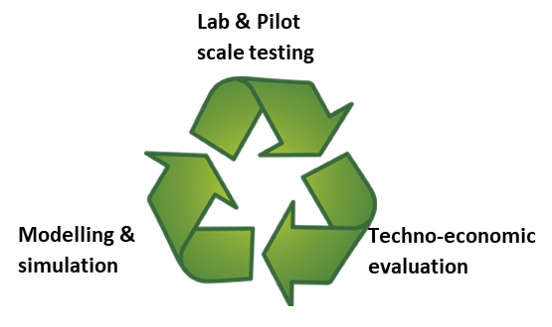Infrastructure - CO2 Impact Gemini Centre
Infrastructure
Information about infrastructure at the CO2 Impact Gemini Centre will be updated.
Infrastructure at NTNU
The solvent characterization infrastructure at NTNU can be used for thermodynamic, kinetic, and solvent degradation studies. Our lab pilot allows for testing of new solvents.
Understanding the chemical and physical equilibria (VLE) behavior of the solvent system is maybe the most critical data needed for process development and process simulations.
Different setups allow measurement of VLE:
- Low and medium pressure VLE setups cover temperatures from 25 and 140oC and up to 5 bars, with one of them enabling direct measurement of the amount of CO2 in the gas phase.
- High-pressure VLE setup allows measurements up to 200bar and 200oC. The equipment is typically used for high-pressure applications or for applications where methane solubility is of interest. Both liquid and gas phases are sampled and analyzed with GC.
- Our calorimeters can provide both the heat of absorption of CO2 and vapor-liquid equilibrium studies. One of the calorimeters allows for the heat of crystallization and dissolution studies.
We have basic analytical possibilities (amine and CO2 titration methods and TOC / TIC / NT) available in our labs. Additionally, we have the equipment to measure physical properties like density and viscosity.
Absorption kinetics are crucial when estimating the height of the absorber and during process simulations. Additionally, to absorption rate data, data for physical properties are needed to model the kinetics.
Measurement of absorption kinetics can be performed with three different setups:
- a string of discs
- a wetted wall column
- a stirred cell
Both CO2-loaded and unloaded solutions can be measured. Additionally, the measurement of viscosity, density can be performed at the conditions used to measure the kinetics. Finally, the physical solubility of CO2 using the N2O-analogy can be determined.
We have basic analytical possibilities (amine and CO2 titration methods and TOC / TIC / NT) available for liquid analyses.
Solvent degradation and corrosion can be a show-stopper for process and solvent development. The amount of degradation is one of the factors that dictate the need for solvent make-up. In addition to degradation contributing to the higher cost of solvent make-up, some of the degradation compounds formed have unwanted properties like high corrosivity or high volatility. For example, volatile degradation compounds might escape from the absorber and increase the process's environmental impact if not adequately controlled. Furthermore, a fundamental understanding of corrosion and degradation is the key when developing countermeasures for degradation. Understanding the connection of different process parameters and degradation compounds is, therefore, of high interest.
We can measure oxidative degradation in batch reactors. In contrast, thermal degradation tests are performed in metal cylinders up to 150oC. The amount of CO2 and access to metals can be controlled by placing a glass tube inside the cylinder.
We have basic analytical possibilities (amine and CO2 titration methods and TOC / TIC / NT) available for liquid analyses. We have good collaboration with SINTEF biotechnology providing analytical services.
The pilot was built in 1998 and upgraded in 2004.
The gas treating capacity of the pilot plant is approximately 150 m3/h.
The absorber (ID = 0.15m) has a packing height of 4.23m, whereas 3,57m of packing is available in the stripper section (ID 0.1m).
The pilot is fully automated with continuous logging of the liquid and gas flows, the temperature profiles in the packed columns (seven probes in the absorber and five probes in the stripper), the CO2 concentrations in and out of the absorber, the reboiler heat duty and temperatures and pressures in the pipes.
The absorber is connected to a water wash section with a height of 2.1m and an internal diameter of 0.15m. The total amount of liquid solution needed for operation is ~180l.
The pilot is operated continuously (24-hours), and no operator is required in the evenings/nights. The plant is specially designed for solvent testing in post-combustion and can be used for:
- testing of new potential amines
- testing degradation in the long-term campaigns (it is possible to add NO/NO2 into the gas phase)
- water wash experiments
- testing of new technics related to emission control.
Infrastructure at SINTEF
SINTEF has similar equipment for solvent characterization and phase equilibrium measurements as listed for NTNU above. Additionally, set-ups for studying the chemical stability of various solvent at batch conditions (oxidative and thermal degradation) and a small rig studying process degradation (circulation of solvent between absorber and desorber) is also available.
For characterization of the samples a combination of wet chemical analysis, available in close proximity to the laboratory set-ups, and more advanced research-based analyses (Mass spectrometry - Advanced research-based analyses) are used.
A simulation software package, CO2SIM, has been developed for simulation of absorption-based CO2 capture (CO2-capture: Process modelling and simulation - SINTEF). This is used in combination with our lab facilities to develop new solvents and concepts for CO2 capture.
In 2010, the CO2 Laboratory at Tiller was opened, located approximately 10 km from the NTNU campus in Trondheim. The CO2 laboratory at Tiller is a highly equipped test facility for development of post-combustion CO2 capture technologies, as well as a research lab for flue gas pre-treatment analysis and emission research. The pilot plant consists of a complete absorption and desorption plant with a CO2 capacity up to 60 kg CO2/h. It is also fully automated, with long time operational capabilities. More information about the CO2 laboratory below.
The plant is designed such that the results from the plant can easily be upscaled to industrial size columns by simply increasing column diameters. It is equipped for accurate measurements of key process variables including:
- Energy requirements
- CO2 absorption capacity
- Emission to air
- Degradation of solvents
- Other key process parameters
Flue gas is provided either from a propane burner (380 kW) or a coal/bio burner depending on the testing conditions.
The absorption column has an inner diameter of 20 cm and the column is equipped with 19.5 meter structured Mellapak 2X packing divided in 4 sections. Liquid collector and redistributor sections (in-house SINTEF design) are installed between each section and facilitate sampling of both gas and liquid. Between each section the liquid can be withdrawn and cooled before it is entered back into the column This gives an opportunity to get more optimal temperature condition in the absorber. The column is instrumented with temperature sensors every meter, and pressure sensors below each packed section. Above the 4th absorption section, two water-wash sections with structured Mellapak 2X packing are used to remove amine vapor in the flue gas. It is also possible to use two additional water wash sections to get improved control of the emissions. The last section is equipped with pH control and may be used as an acid wash. Demisters are placed above the upper lean solvent distributor and above the upper water section as well as in the top of the two additional water wash sections.
The solvent regeneration system consists of reboiler, desorption column and two condensers to separate stripped CO2 and water/amine vapor. Recovered CO2 will be discharged to the atmosphere or recirculated to the feed gas system upstream the DCC to increase the CO2-concentration.
The stripper column has an inner dimater of 16.2 cm, and the stripper column is equipped with 13.6 meter structured Mellapak 2X packing consisting of 3 sections with solvent collector and redistribution between each section. The liquid may be heated before redistribution to a lower section. The two inter-heaters have a capacity of 10 kW each. The collector and the redistributor are of similar design as in the absorber. The column is equipped with temperature and pressure sensors like the absorber column. The stripper column and the reboiler are equipped with a heat tracing system ensuring no heat loss to the surroundings. The upper part of the stripper column has two water-wash sections like the water wash in the absorber. Demisters are placed above the upper (rich) solvent distributor and above the upper water distributor to remove entrained droplets.
Two plate and frame heat exchangers are used for the lean/rich flows. Each exchanger consists of 20 m2 of surface area and it is possible to use only one of them or both in series to investigate the impact of the surface area.
The whole plant is controlled by a process control system from Siemens (PCS 7). Additionally, an advanced control system based on Nonlinear Predictive Control has been integrated for improved control of the energy requirement in the reboiler.
Contact

Professor, NTNU
E-mail: hanna.knuutila@ntnu.no

Research Manager,
SINTEF Industry
E-mail: Eirik.Silva@sintef.no

Professor, USN
E-mail: Lars.Oi@usn.no

